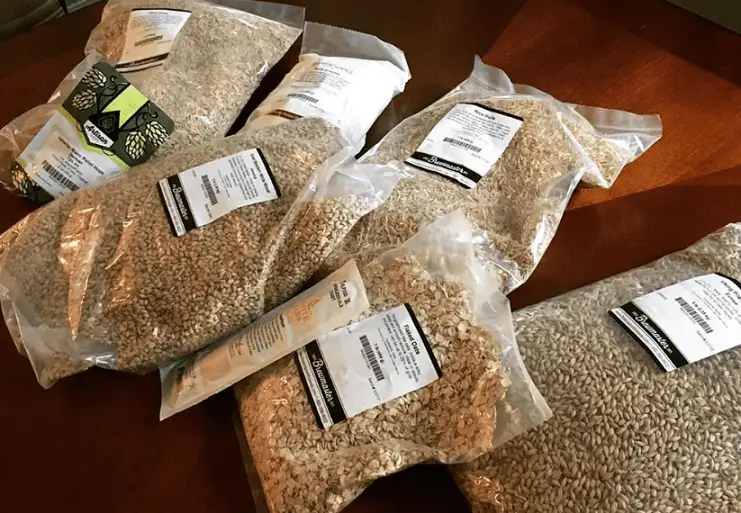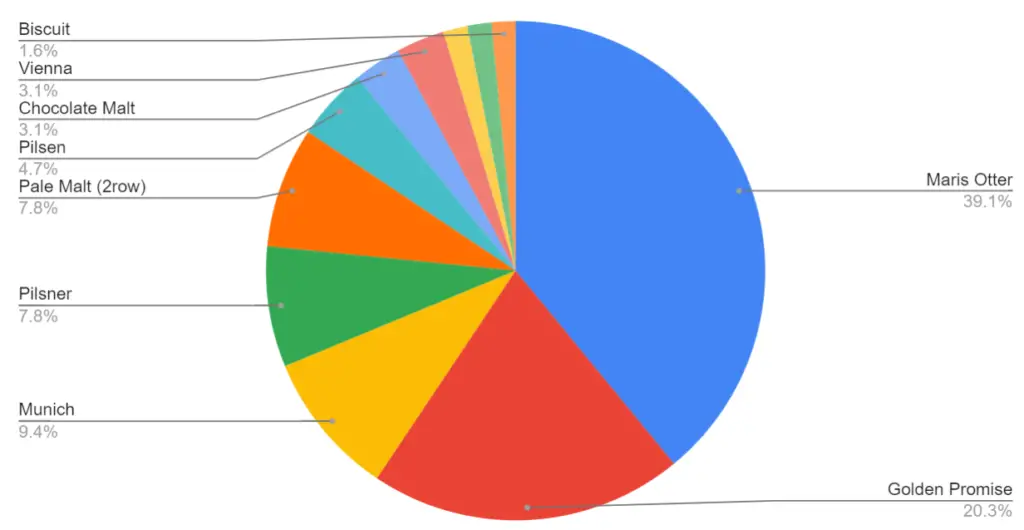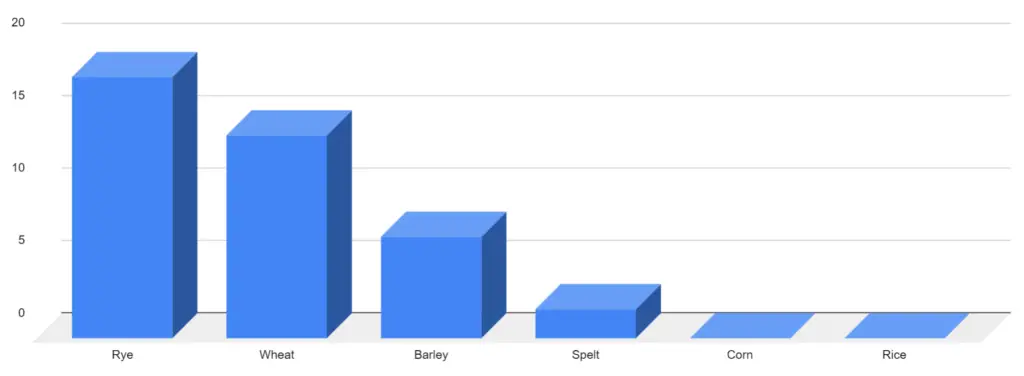
Homebrewing beer seems fairly straightforward, there are only 4 ingredients after all. Hops, malt, water and yeast. But, what type of malt should you add? There are tons of different varieties of barley. Not to mention all of the adjunct grains that can be used in beer.
Maris Otter is the most popular barley grain that is used among homebrewers. It’s versatility and ability to exist as both a base malt and specialty malt makes it a prime choice among the homebrewing community. Pale 2-row is the most commonly used malt in commercial beer brewing.
Maris Otter is a base malt, but I was surprised it was mentioned so many times. No other malt was mentioned more, and while I thought specialty malts would have more of a presence in my survey, base malts are on top of mind for many homebrewers.
Homebrewer Survey of the Most Popular Brewing Grains
Frugal Homebrew prides itself on trying to find ways to reduce costs and one of the best ways is to buy grain in bulk. But, how do you know what grain will be the most worthwhile to purchase? One way is to survey a large group of homebrewers.
I surveyed a Facebook group to see just what malts where being used by homebrewers and which ones got the most likes and mentions and here are the results.

At the top of the list was Maris Otter followed by Golden Promise. These are both base malts with fairly low color levels or SRM. They do however contribute to a very different flavor and color than a pale 2 row or pilsner malt.
It sort of makes sense homebrewers would choose to utilize more flavorful malts as their go to base malt. The reason behind this likely involves the ease of brewing more traditional ales.
Homebrewers are likely to want a lot more character and flavor in their brews and the easiest way to get this is to start with a more flavorful base malt.
Brewing with Lighter Malts
Behind Munich malt we have 3 very pale malts that are usually used in lagers, pale ales and IPA’s. The common theme among these malts is the brewer is going for a super clean and clear look and taste.
These malts provide that clean and clear look, but being a beginner homebrewer it can take a lot of familiarity with the brewing process to achieve a crystal clear look. Not to mention the equipment that is required to lager a beer long term.
Maris Otter and Golden Promise
Maris Otter and Golden Promise were the two frontrunners when asked which grain homebrewers liked most. These two malts have a higher SRM than the traditional pale malts used commercially. They also end up with more flavor because of the higher level of toasting.
This makes the two a bit more expensive than a pale malt. But, among homebrewers that are concerned with creating excellent beers for a fraction of the cost of buying one going with higher quality is the obvious choice.
One note about Maris Otter and Golden Promise is that they have lower levels of diastatic power than a pale malt. They certainly have enough to convert themselves but if you are mixing with other malts that have lower levels of diastatic power its something to take into consideration.
A History of Maris Otter
Maris Otter has an extremely interesting history. It also has the longest running streak of being a favorite among brewers and has a lot of award winning beers under its belt.
Check out the video below to learn a bit about how its grown today.
Maris Otter is typically used in English ale recipe’s and any darker maltier beers. Some of these may include:
- Stout
- English Bitter
- Brown Ale
- Wee Heavy
- Malty IPA
Golden Promise Craft Malt
Golden Promise is also more expensive that a typical pale ale or 2-row malt, but equal in price to Maris Otter. Golden promise is even sweeter than Maris Otter but can sometimes be harder to find. Most of the Golden Promise malt comes from Scotland but you may be able to find some floor malted varieties locally in the United States.
If you are buying Golden Promise you will most likely find it from Simpsons. They produce the malt that comes out of Scotland. Golden Promise Malt is famously used in the following beer styles:
- English or Scottish Ale
- Malty American IPA
- Pale Ales and Lagers
Golden Promise is a bit different in that it can be used for lighter beers than a Maris Otter Malt can. Although it is sweeter than Maris Otter it produces a cleaner flavor.
Most Popular Adjunct Grains for Experimentation
The most popular grain used is Barley and the most popular grain variety is Maris Otter. But, I also wondered how alternative grains ranked on the list of popularity.
These grains are typically referred to as adjuncts since barley the number one grain used in beer. But, there are other grains that can be used in brewing and even be used as base malts, although it may be a bit more difficult.
Below I asked the question what is your favorite grain to experiment with:

I was expecting wheat to win by a large margin. After all there are many more famous beer styles that use it. But, rye won out as the most experimented style of grain.
Rye may be gaining traction in the homebrewer world and its possible we could be seeing many more beers in the future with a rye element added to it.
The Losers on the List
I was surprised a bit by the lack of votes for corn or rice. It is possible that these are shunned by homebrewers because they are utilized in many cheap beers on the market. However, the use of rice took me by surprise as many Asian style beers utilize rice for a light body and yet remain malty.
Spelt on the other hand was a surprise that it got any votes. But, after some further research I learned it could be the oldest ingredient in beer and some renewed interest may be pushing it back up to the top. Only time will tell whether or not this ingredient will gain a greater foothold.
Specialty Grains vs Base Grains
Most of the above malts discussed are utilized as base grains. Base grains have the highest amount of fermentable sugar and strong diastatic power. These grains are also kilned vs roasted. This means they are dried out after being malted at much lower temperatures over longer periods of time.
Specialty malts are often used to add complexity to beer. They are often used to change the color of the beer and add different flavors. These grains are more often roasted, which means they are heated to higher temperatures over shorter periods of time. This darkens the grain and they often have higher SRM. Which is the method used to distinguish malt color.
Although most specialty malts are considered to be roasted vs kilned this is not always the case. Specialty malts could also be considered a base malt if they are rare enough.
For example Maris Otter can sometimes be considered a specialty malt because of its flavor profile. Other specialty malts closely resemble pale malts part are created though unique processes used by floor malters that are part of the craft malting guild.
Buying Malts in Bulk for Cost Efficiency
Buying grains in bulk is often the best way to save on cost. Maris Otter hits the sweet spot for homebrewers since it is not overly expensive to homebrew with. Make sure to pick yourself up a bag of either Maris Otter or Golden Promise from Adventures in Homebrewing.
If the mainstream craft brewing community utilized Maris Otter more regularly it could drive up the price. So be thankful you can buy it in bulk and save some good money for great beer.
Alternatively the Craft Malters Guild is growing and many more craft malters are appearing everyday. Often time because of their local presence they can even sell quality specialty grain for much cheaper than you would find online. If you find an excellent craft malter, make sure you support them and get your grain at a cheaper price with higher quality.
